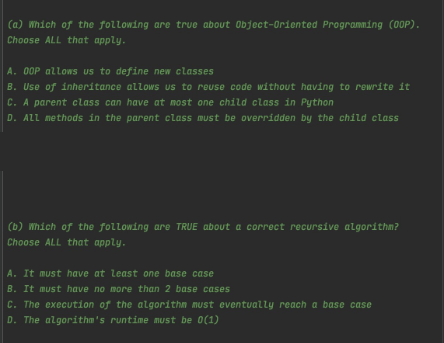(a) Which of the following are true about Object-Oriented Programming (O0P). Choose ALL that apply. A. OOP allows us to define new classes B. Use of inheritance allows us to reuse code without having to rewrite it C. A parent class can have at most one child class in Python D. ALL methods in the parent class must be overridden by the child class (b) Which of the following are TRUE about a correct recursive algorithm? Choose ALL that apply. A. It must have at least one base case B. It must have no more than 2 base cases C. The execution of the algorithm must eventually reach a base case D. The algorithm's runtime must be 0(1)
(a) Which of the following are true about Object-Oriented Programming (O0P). Choose ALL that apply. A. OOP allows us to define new classes B. Use of inheritance allows us to reuse code without having to rewrite it C. A parent class can have at most one child class in Python D. ALL methods in the parent class must be overridden by the child class (b) Which of the following are TRUE about a correct recursive algorithm? Choose ALL that apply. A. It must have at least one base case B. It must have no more than 2 base cases C. The execution of the algorithm must eventually reach a base case D. The algorithm's runtime must be 0(1)
C++ Programming: From Problem Analysis to Program Design
8th Edition
ISBN:9781337102087
Author:D. S. Malik
Publisher:D. S. Malik
Chapter15: Recursion
Section: Chapter Questions
Problem 20SA
Related questions
Question
It's all one question

Transcribed Image Text:(a) Which of the following are true about Object-Oriented Programming (00P).
Choose ALL that apply.
A. OOP allows us to define new classes
B. Use of inheritance allows us to reuse code without having to rewrite it
C. A parent class can have at most one child class in Python
D. ALL methods in the parent class must be overridden by the child class
(b) Which of the following are TRUE about a correct recursive algorithm?
Choose ALL that apply.
A. It must have at least one base case
B. It must have no more than 2 base cases
C. The execution of the algorithm must eventually reach a base case
D. The algorithm's runtime must be 0(1)
![(c) You're reading the docstring of the do_something () method of the Mystery
class. The docstring says the following:
Precondition: Len(self.items) > 148
Postcondition: Len(self.items) < 148
Assume that the class is designed and documented properly.
Which of the following are TRUE? Choose all that apply.
A. Len(items) == 147 is a possible representation invariant of Mystery
B. Len(items) == 148 is a possible representation invariant of Hystery
C. Len(items) == 149 is a possible representation invariant of Hystery
D. None of the above is a possible representation invariant of Hystery
(d) Given a non-empty binary tree T, let list L1 be the preorder traversal of
T and list L2 be the postorder traversal of T. Which of the following are TRUE?
Choose ALL that apply.
A. Len(L1) and len(L2) are the sae
B. L1 is L2 reversed
C. Li[0] is the
D. Either L1 or L2 must be a sorted list.
same as L2[-1]](/v2/_next/image?url=https%3A%2F%2Fcontent.bartleby.com%2Fqna-images%2Fquestion%2F50700bcb-7eae-4627-8f9a-d21c0cbd1fac%2Fc17d65e1-b615-4144-80cd-9151cd659377%2Fkkof35f_processed.png&w=3840&q=75)
Transcribed Image Text:(c) You're reading the docstring of the do_something () method of the Mystery
class. The docstring says the following:
Precondition: Len(self.items) > 148
Postcondition: Len(self.items) < 148
Assume that the class is designed and documented properly.
Which of the following are TRUE? Choose all that apply.
A. Len(items) == 147 is a possible representation invariant of Mystery
B. Len(items) == 148 is a possible representation invariant of Hystery
C. Len(items) == 149 is a possible representation invariant of Hystery
D. None of the above is a possible representation invariant of Hystery
(d) Given a non-empty binary tree T, let list L1 be the preorder traversal of
T and list L2 be the postorder traversal of T. Which of the following are TRUE?
Choose ALL that apply.
A. Len(L1) and len(L2) are the sae
B. L1 is L2 reversed
C. Li[0] is the
D. Either L1 or L2 must be a sorted list.
same as L2[-1]
Expert Solution
This question has been solved!
Explore an expertly crafted, step-by-step solution for a thorough understanding of key concepts.
Step by step
Solved in 2 steps

Knowledge Booster
Learn more about
Need a deep-dive on the concept behind this application? Look no further. Learn more about this topic, computer-science and related others by exploring similar questions and additional content below.Recommended textbooks for you

C++ Programming: From Problem Analysis to Program…
Computer Science
ISBN:
9781337102087
Author:
D. S. Malik
Publisher:
Cengage Learning

C++ Programming: From Problem Analysis to Program…
Computer Science
ISBN:
9781337102087
Author:
D. S. Malik
Publisher:
Cengage Learning